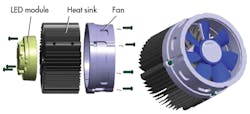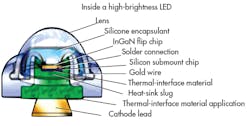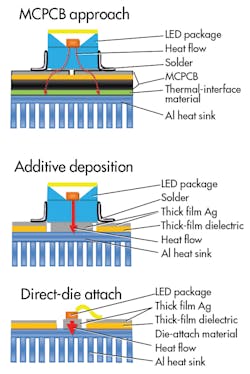Resources:
The Bergquist Co., Dow Corning LED Lighting Solutions, www.dowcorning.com ebm-papst Inc., www.ebmpapst.us
GrafTech International, Heraeus Precious Metals North America, www.heraeus-celcion.com Xicato, www.xicato.com |
One parameter has stayed the same as light-emitting diodes have begun lighting up rooms and taking over other tasks once dominated by incandescent bulbs: Even the best LEDs still dissipate about 70% of the power they consume as heat. That reality makes heat dissipation a top priority for designers of lighting based around illumination-grade LEDs.
Long term, LED makers are working on innovative chip-packaging ideas that will help route heat away from the LED die. But for the next few years, cooling efficiency will largely depend on connecting LEDs to heat sinks through means that offer as little thermal resistance as possible. So makers of so-called thermal-interface materials are putting a lot of thought into optimizing thermal paths. In the case of LEDs, the usual task of the thermal interface is to provide a route for LED heat to a heat sink while also keeping energized surfaces electrically insulated. And increasingly, the cost of the thermal interface is an issue as manufacturers try to devise LED lighting at a price economical enough to compete with ordinary light bulbs.
One reason LED economics need improvement is that many parts of the assembly process are still manual. “In south China, you can still see people screen-printing boards by hand,” says Geoff Gardner, Dow Corning Electronic Solutions Global Industry Director for Advanced LED Packaging, Midland, Mich. He says these simple assembly methods are giving way to automation, particularly when the thermal interface takes the form of a pad placed between the LED package and a circuit board. “The big limitation of a pad is its placement. Some pads are relatively elaborate. You need high-end robotic equipment to line up pads repeatedly because you get a lot of yield losses from hand placement.”
“Originally, thermal interfaces often took the form of solid sheets, but the placement of a solid sheet is often a manual process which is not efficient when volumes are rising,” says Nico Bruijnis, business development manager at Bergquist Co., Chanhassen, Minn, a maker of heat-management materials for electronics. “Consequently, we see a very strong trend to liquid materials which can be either screen printed or dispensed, with the latter being the recommended approach for high-volume manufacturing.”
There are different problems when the thermal interface is a liquid. Some materials can outgas, and this gas may cause fogging on lenses or reflectors, explains Bruijnis. The most problematic situations are those where the design is sealed and the thermal-transfer material is a big, thick sheet.
Another example of possible difficulties comes from Dow Corning’s Gardner. Dow markets a lot of liquid thermal-interface material based on various mixes of silicone. But the silicone used to heat sink LEDs isn’t like the stuff you might use to caulk your bathtub. Ordinary silicone doesn’t conduct heat well. In contrast, the silicones Dow makes for thermal interfacing are filled to a great degree with particles of conductive material such as aluminum and aluminum oxide, zinc oxide, or silver. The filler boosts their viscosity and, thus, makes them more difficult to dispense from nozzles. Needle tips can work for slower uses, says Gardner, but higher volumes may force the use of an assembly facility that has specialized dispense equipment.
Use of metallic filler isn’t the only difference between thermal-interface silicone and that used for weatherproofing. Gardner says silicone targeting electronics has higher quality requirements centered around consistency and thermal conductivity and different cure systems — the acetic acid smell associated with silicone caulk is absent from that used with semiconductor devices.
Another reason silicone makes a good thermal interface is a high degree of surface wetting so it maintains contact with circuit components and minimizes the impact of an intervening barrier. Silicone-wetting qualities are better than that of some competing liquids such as silver-filled epoxy or other polymeric compounds, Gardner says.
Designers working with dielectric materials make other trade-offs as well. Better thermal performance sometimes calls for reducing the thickness of the dielectric, but this strategy will also reduce the dielectric strength, points out Bergquist’s Bruijnis. In addition, any carrier like foil or fiberglass used in the structure of a dielectric will make it tougher for heat to pass through it.
Circuit boards and substrates for LED mounting get scrutiny for thermal properties as well. Bruijnis says its customers are using both thermal-clad boards such as metal-core PCBs (MCPCBs) and ordinary FR4 boards. “FR4 can still be used when the power densities aren’t quite as high, though the FR4 board will often incorporate thermal vias to reduce the board thermal impedance,” he says.
MCPCBs used with higher-power LEDs incorporate a base metal, usually an aluminum or copper alloy, that acts as a heat spreader. Covering the metal is a dielectric polymer layer optimized to conduct heat. Another widely used substrate material consists of aluminum onto which a thick-film dielectric is deposited where needed. The resulting additive-deposition process is said to provide a more direct connection to the aluminum heat sink. One such system, called Heraeus Celcion, is said to reduce the junction temperature of the LED by up to 10°C below that seen on MCPCBs.
Luminaire heat
The thermal interfaces used for connecting an LED module to a luminaire or a heat sink tend to be even-more cost sensitive than those at the chip level. “The thermal interface at this level must be amenable to low-cost processing techniques. The needs for thermal conductivity typically are not as important, but workability really matters,” says Dow Corning’s Gardner. “You are assembling an expensive part. If there is an error, you need to be able to take it apart and reuse it.”
“The main trend we’re seeing right now is a cost-reduction effort on the thermal design that often means taking out the active cooling where possible,” says Bergquist’s Bruijnis. Still, it’s likely that luminaires for high-brightness LEDs will continue to incorporate active cooling such as fans for some time to come. One approach fan makers now employ is to make fans in form factors specific to widely used LED module standards. An example comes from fan maker ebm-papst Inc., Farmington, Conn. It makes fans designed with integral heat sinks that fit directly onto LED modules from light supplier Xicato, San Jose. These are axial fans that use brushless-dc motors that consume 180 mW at most.
One way to eliminate active cooling of LED modules is to employ more-clever heat sinking. Sometimes that task involves use of heat-sinking material that is on the exotic side. An example is heat-sink material based on graphite, developed by GrafTech International, Parma, Ohio. Called Spreadershield, it has a thermal conductivity that can be engineered to reach 1,500 W/m‑K, a level better than that of copper and aluminum. It is also flexible enough to conform to package contours and can have a minimum thickness of 0.05 mm (0.002 in.). Moreover, it is 80% lighter than copper and 30% lighter than aluminum.




